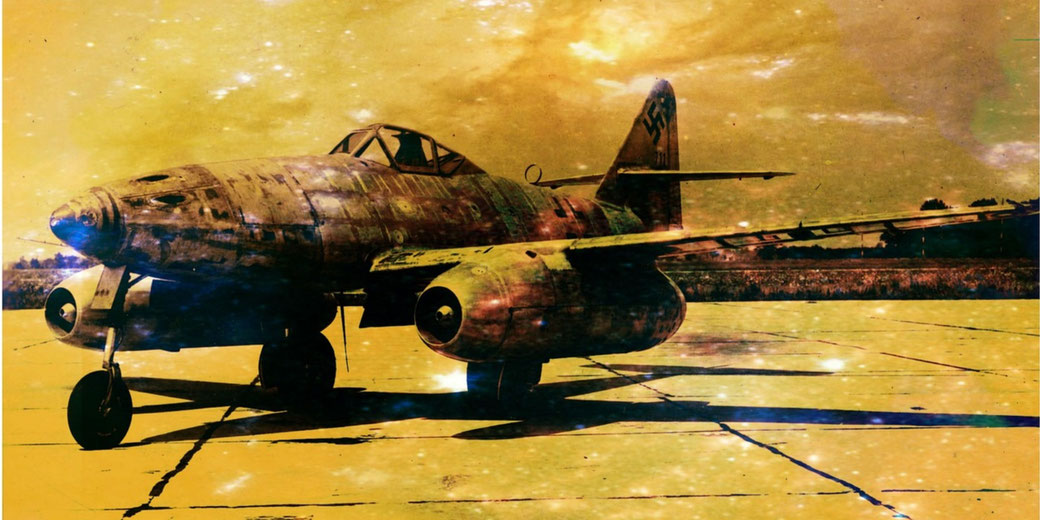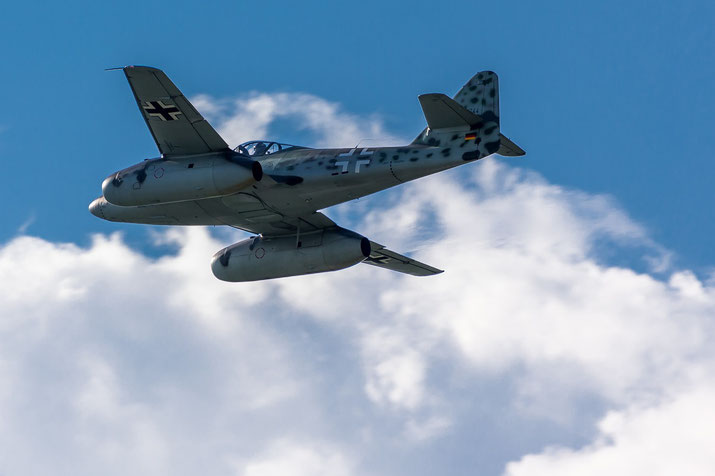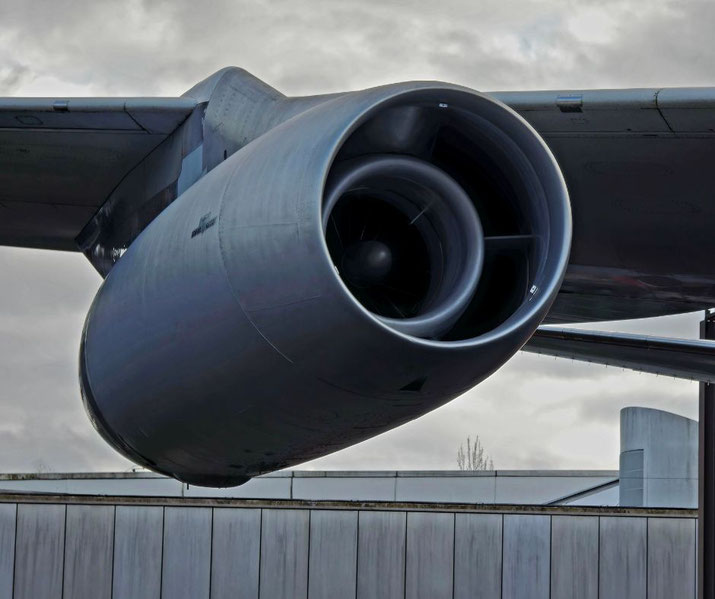Messerschmitt Me 262: How the world's first jet fighter was built by the Nazi Germany

At the apex of World War II, a pioneering innovation took to the skies and forever changed the face of aviation.
The Messerschmitt Me 262, the world's first operational jet-powered fighter aircraft, streaked across the tumultuous tapestry of war with a blend of speed and power previously unseen.
Its swept wings and distinctive shape cast an indelible silhouette that would mark the dawn of a new era in flight.
How did the concept of this revolutionary aircraft come into existence, and what challenges did the designers face?
What made the Me 262 a formidable machine during the war, and how did its pilots perceive it?
And most importantly, how did this groundbreaking aircraft shape the future of aviation in the years that followed the end of World War II?
The design and testing of a new kind of aircraft
The genesis of the Messerschmitt Me 262, codenamed "Swallow," traces back to the early 1930s when the principles of jet propulsion started to emerge.
However, it wasn't until 1939 that the project formally commenced, a visionary endeavor that sought to marry these groundbreaking principles with practical military aircraft design.
Driven by a team led by chief engineer Waldemar Voigt, the aircraft design sought to leverage the untapped potential of jet propulsion to outmatch any existing piston-engine counterparts.
But the journey from blueprints to tangible machine was far from seamless.
Technical challenges abounded in these early years, primarily concerning the jet engines themselves.
At the heart of the Me 262 were the Jumo 004 turbojets, developed by Junkers. These engines promised unrivaled power, but they were prone to mechanical failures and had a disturbingly short operational lifespan.
They required a significant amount of rare metals, which were hard to come by during the war, prompting a redesign that used more available materials.
This redesign added further delay to the aircraft's development process.
Another key challenge was the initial configuration of the engines. The first prototypes had the engines mounted on the fuselage, but the design was subsequently altered to mount them on the wings due to concerns about the center of gravity and the potential for catastrophic engine fires.
The Me 262's distinctive swept-wing design also emerged during this period.
Although primarily a product of high-speed aerodynamic considerations, the iconic swept wings would go on to significantly influence post-war aircraft designs.
By 1941, the first prototype, the Me 262 V1, was ready for its maiden flight. However, due to the underdevelopment of the jet engines, the aircraft had to rely on a conventional piston engine mounted in the nose.
It was not until November 1941 that the Me 262 V3, the third prototype, took to the air powered entirely by jet propulsion.
Yet the aircraft's development would still be hampered by bureaucratic disputes and strategic disagreements, causing delays that allowed the Allies to advance their own jet projects.
The race to build the new plane
As the design and development phase of the Messerschmitt Me 262 overcame its technical challenges, the focus shifted to production.
The task of turning the newly refined prototypes into a viable fighting force was a complex endeavor, compounded by the ever-growing constraints of the Second World War.
With material shortages, strategic missteps, and the intensifying Allied bombing campaign, production of the Me 262 was anything but straightforward.
Germany began the mass production of the Me 262 in April 1944. Despite its innovative design, producing the aircraft on a large scale was a logistical challenge.
The manufacturing process was distributed across multiple factories throughout Germany, including those operated by Messerschmitt, Heinkel, and Junkers, and even involved underground factories to protect from Allied bombing.
Each factory was responsible for a different part of the aircraft, from engines to fuselage sections and wing components.
This distributed production strategy aimed to mitigate the risk of complete disruption due to potential attacks but led to coordination challenges and inconsistencies in quality control.

Production was further hampered by strategic decisions. Adolf Hitler, upon seeing the Me 262 for the first time, insisted that the aircraft be used as a bomber rather than a fighter.
The redesign required to meet this demand resulted in a significant delay in its production, a diversion that arguably cost Germany a chance to gain air superiority.
Although some Me 262s were used as bombers, they proved most effective as fighters and interceptors.
By the end of the war, Germany had produced approximately 1,430 Me 262s, but only a fraction of these saw active service.
Due to fuel shortages and lack of trained pilots, many were never used in combat. The aircraft that were deployed showcased impressive speed and firepower but arrived too late to turn the tide of the war.
The Me 262 was mainly deployed in the defense of the German homeland, where its superior speed allowed it to engage and break off at will, making it a formidable adversary for the Allied bombers.
How effective was it in combat?
The operational history of the Messerschmitt Me 262 is as storied and complex as its design and production.
The aircraft, first and foremost a pioneering feat of engineering, was thrust into an equally groundbreaking role in the waning stages of World War II.
Its operational career, though relatively brief, showcased its profound potential and influence.
The Me 262 made its operational debut in July 1944, when a lone aircraft engaged a British de Havilland Mosquito reconnaissance aircraft over Munich.
This marked the first known encounter of an Allied aircraft with a jet fighter. Over the following months, the Me 262 was gradually introduced into the Luftwaffe's fighter and interceptor units, predominantly those tasked with the defense of the German homeland against Allied bombing raids.
Although the Me 262 entered service too late to decisively impact the outcome of the war, its presence was significant.
The aircraft's exceptional speed and heavy armament, typically four 30mm MK 108 cannons, made it a lethal adversary for the slower, propeller-driven bombers of the Allies.
It was capable of outrunning any Allied fighter, making it nearly impossible to intercept in a conventional dogfight.
Notable successes were achieved by the pilots of the Me 262, some of whom became jet aces.
Perhaps the most famous of these was Major Walter Nowotny, who scored several victories in the Me 262 before his untimely death during combat in November 1944.
Despite such individual successes, the overall impact of the Me 262 on the war was limited by the small number that actually saw combat service, compounded by logistical problems such as fuel shortages and the lack of trained pilots.
The operational use of the Me 262 was not without its problems. The aircraft's engines, although advanced, were temperamental and had a short operational life.
The early jet engines also had slow throttle response, making the aircraft tricky to handle during take-off and landing.
In fact, many Me 262s were lost to accidents and mechanical failures rather than enemy action.
The 262's influence on modern jet aircraft
The Messerschmitt Me 262 not only marked a monumental leap in aviation during its time, but its technological innovations and design features would also have a far-reaching influence on subsequent aircraft designs, cementing its place in the annals of aviation history.
Undoubtedly, the most transformative innovation of the Me 262 was its jet propulsion system.
With its twin Jumo 004 turbojet engines, the Me 262 became the first operational jet-powered fighter aircraft in the world.
This novel use of jet engines dramatically increased the aircraft's top speed and climb rate, offering a significant advantage over propeller-driven aircraft.
This laid the groundwork for the universal adoption of jet propulsion in military and civilian aircraft in the years following World War II.
The Me 262's airframe design was another key aspect of its innovation. Its distinctive swept-wing design, adopted to counter the effects of compressibility at high speeds, was a pioneering feature that would greatly influence the design of future high-speed aircraft.
This design attribute would later be seen in notable aircraft of the Cold War era, including the American F-86 Sabre and the Soviet MiG-15.
The influence of the Me 262 extended beyond its technological and design features. Its deployment demonstrated the significant tactical potential of jet-powered aircraft, leading military strategists worldwide to reconsider their approach to air combat.
The Me 262 showed that speed and firepower could provide a decisive advantage in aerial engagements, shaping the direction of fighter aircraft development in the post-war era.
The Me 262's influence can also be seen in the development of the post-war aerospace industry.
Many captured Me 262s were shipped to the United States, the United Kingdom, France, and the Soviet Union, where they were meticulously studied.
This examination of German jet technology significantly aided these countries' own jet aircraft development programs.
From its pioneering use of jet propulsion to its sweeping wing design, the aircraft reshaped the landscape of aviation technology and strategy.
Despite its brief operational history, the Me 262's legacy endures in the jets that rule our skies today.
Its echoes are seen in every sleek fuselage, heard in every roaring jet engine, and felt in the swift response of every modern fighter.
The Me 262 was not just a product of its time, but a precursor to the future.

What do you need help with?
Download ready-to-use digital learning resources
Copyright © History Skills 2014-2025.
Contact via email
With the exception of links to external sites, some historical sources and extracts from specific publications, all content on this website is copyrighted by History Skills. This content may not be copied, republished or redistributed without written permission from the website creator. Please use the Contact page to obtain relevant permission.





